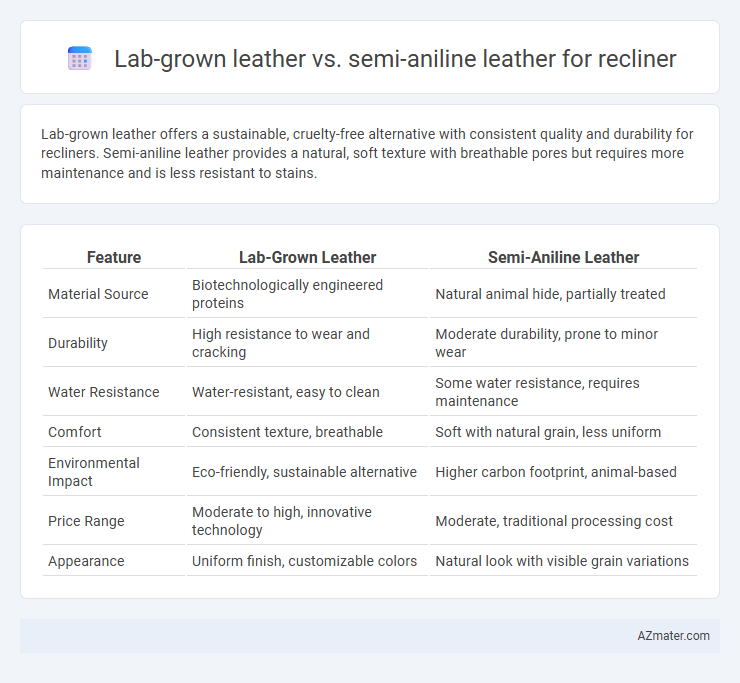Lab-grown leather offers a sustainable, cruelty-free alternative with consistent quality and durability for recliners. Semi-aniline leather provides a natural, soft texture with breathable pores but requires more maintenance and is less resistant to stains.
Table of Comparison
| Feature | Lab-Grown Leather | Semi-Aniline Leather |
|---|---|---|
| Material Source | Biotechnologically engineered proteins | Natural animal hide, partially treated |
| Durability | High resistance to wear and cracking | Moderate durability, prone to minor wear |
| Water Resistance | Water-resistant, easy to clean | Some water resistance, requires maintenance |
| Comfort | Consistent texture, breathable | Soft with natural grain, less uniform |
| Environmental Impact | Eco-friendly, sustainable alternative | Higher carbon footprint, animal-based |
| Price Range | Moderate to high, innovative technology | Moderate, traditional processing cost |
| Appearance | Uniform finish, customizable colors | Natural look with visible grain variations |
Introduction to Recliner Upholstery Options
Lab-grown leather offers a sustainable and cruelty-free alternative to traditional upholstery materials for recliners, combining durability with an eco-conscious appeal. Semi-aniline leather retains natural texture and breathability through a light pigment coating, balancing softness and stain resistance ideal for high-use furniture. Choosing between lab-grown leather and semi-aniline leather depends on preferences for environmental impact, maintenance, and tactile experience in recliner upholstery options.
What is Lab-Grown Leather?
Lab-grown leather, also known as cultured or biofabricated leather, is created by cultivating animal cells in a controlled lab environment to produce genuine leather without raising livestock. This innovative material offers a sustainable alternative with less environmental impact compared to traditional leather production. Semi-aniline leather, often used in recliners, is dyed with minimal surface coating to preserve natural texture but still relies on animal hide, contrasting with the cruelty-free and eco-friendly attributes of lab-grown leather.
What is Semi-Aniline Leather?
Semi-aniline leather is a high-quality leather type treated with a light protective coating, preserving its natural texture while offering increased durability and stain resistance compared to full-aniline leather. Lab-grown leather, created through bio-engineering processes, mimics the look and feel of traditional leather but offers sustainable and ethical benefits without animal use. For recliners, semi-aniline leather provides a balance of softness and resilience, making it a popular choice for comfort and longevity in furniture upholstery.
Key Differences: Lab-Grown vs. Semi-Aniline Leather
Lab-grown leather offers a sustainable alternative by being produced from cultured cells, reducing environmental impact compared to semi-aniline leather, which is derived from natural animal hides treated with minimal pigmentation for a soft, natural look. Lab-grown leather provides consistent texture and customization options, while semi-aniline leather maintains unique imperfections and breathability due to its natural origin. Durability varies as semi-aniline leather ages gracefully with patina, whereas lab-grown leather emphasizes uniformity and ethical appeal for recliner upholstery.
Comfort and Feel: Recliner Experience Compared
Lab-grown leather offers a consistent texture and improved breathability, enhancing comfort during extended recliner use, while semi-aniline leather provides a natural, supple feel that softens over time, contributing to a luxurious seating experience. The semi-aniline's minimal coating retains the leather's natural grain, delivering a warm and authentic touch, whereas lab-grown leather boasts durability with a uniform surface that resists wear and temperature fluctuations. For recliners, semi-aniline leather excels in creating a cozy, inviting feel, whereas lab-grown leather prioritizes maintenance ease and eco-conscious comfort.
Durability and Longevity Assessment
Lab-grown leather exhibits superior durability and longevity compared to semi-aniline leather, as its synthetic fibers resist wear, scratching, and UV damage more effectively. Semi-aniline leather, treated with a light protective coating, remains breathable and soft but is prone to fading, staining, and surface wear over time, especially in high-use furniture like recliners. For long-lasting recliners, lab-grown leather offers consistent resilience and maintains structural integrity under daily stress, making it a preferred choice for durability-conscious consumers.
Environmental Impact and Sustainability
Lab-grown leather for recliners significantly reduces environmental impact by eliminating animal cruelty, lowering greenhouse gas emissions, and minimizing water usage compared to traditional leather production. Semi-aniline leather, treated with fewer chemicals than full-aniline, still relies on animal hides and involves tanning processes that generate toxic waste and consume substantial water and energy resources. Choosing lab-grown leather enhances sustainability through biodegradable materials and a smaller carbon footprint, making it a more eco-friendly option for environmentally conscious consumers.
Maintenance and Care Requirements
Lab-grown leather recliners offer superior resistance to stains and require minimal maintenance, needing only occasional wiping with a damp cloth to retain their appearance. Semi-aniline leather recliners demand more careful upkeep, including regular conditioning to prevent drying and cracking due to their delicate, porous surface that absorbs oils and dirt. Choosing lab-grown leather can reduce long-term care efforts, while semi-aniline leather benefits those seeking enhanced natural texture but must commit to consistent maintenance.
Cost Comparison: Lab-Grown vs. Semi-Aniline Leather Recliners
Lab-grown leather recliners generally have higher upfront costs due to advanced biotechnology processes involved, while semi-aniline leather recliners offer more affordable pricing with traditional tanning methods. Semi-aniline leather recliners provide a balance of durability and appearance at a moderate price point, making them cost-effective for long-term use. Lab-grown leather's innovative production may reduce environmental impact but currently commands premium pricing compared to semi-aniline leather in the recliner market.
Which Recliner Upholstery is Right for You?
Lab-grown leather offers a sustainable and eco-friendly alternative to traditional upholstery, boasting durability and a consistent texture ideal for recliners in eco-conscious homes. Semi-aniline leather provides a natural look and softness with a light protective coating, making it a comfortable and stylish choice that ages well over time. Choosing the right recliner upholstery depends on your preference for sustainability, maintenance ease, and the desired balance between natural appearance and durability.

Infographic: Lab-grown leather vs Semi-aniline leather for Recliner
 azmater.com
azmater.com